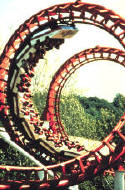Accessible Amusement Rides - A Summary of Accessibility Guidelines for Recreation Facilities
Accessible Amusement Rides
"Whenever any barrier stands between you and the full rights and dignity of citizenship, we must work to remove it, in the name of simple decency and justice. The promise of the ADA...has enabled people with disabilities to enjoy much greater access to a wide range of affordable travel, recreational opportunities and life-enriching services."
President George W. Bush, New Freedom Initiative, February 1, 2001
The recreation facility guidelines described in this guide focus on newly designed or newly constructed and altered amusement rides. Other provisions contained in ADAAG address elements commonly found at an amusement park or theme park, such as accessible vehicle parking spaces, exterior accessible routes, and toilet and bathing facilities. ADAAG addresses only the built environment (structures and grounds). The guidelines do not address operational issues. Questions regarding operational issues should be directed to the Department of Justice, 1-800-514-0301 or 1-800-514-0383 (TTY).
An "amusement ride" is defined by the guidelines as a system that moves people through a fixed course within a defined area for the purpose of amusement. The guidelines do not apply to vehicles such as trams or gondolas, which, while they may be enjoyable, are designed primarily to transport people. These vehicles are addressed in the ADA Accessibility Guidelines for Transportation Vehicles.
New Rides
New rides refer to the “first use,” which is the first time amusement park patrons take a ride on a custom designed or newly manufactured ride. If a ride is moved to another area of a park or to another park, it is not considered new. If the ride was purchased from another entity, “new” is the first permanent installation of the ride, whether it was purchased “off the shelf” or modified before installation.
Altered Rides
Altered rides refer to changes in structural or operational characteristics of an existing ride vehicle configuration from those specified by the manufacturer or the original design criteria. An existing ride is also considered an altered ride if the load or unload area is newly designed or constructed. Thus, if an existing ride is simply moved to another area of a park or to another park, it is not considered altered unless the load or unload area is newly designed or newly constructed. Routine maintenance, painting, or changing the theme boards is not considered an alteration.
Exceptions
There are four types of rides that are not covered by the guidelines. However, other ADA requirements still apply. The four types are:
-
Mobile or portable amusement rides such as those in traveling carnivals, State and county fairs, and festivals, do not need to comply. Mobile rides are available that provide wheelchair access and other rides could provide transfer access with minor modifications.
-
Rides that are controlled or operated by the rider (such as bumper cars and go-carts) are not required to comply with the guidelines, but an accessible route to the ride and a turning space (60-inch diameter circle or T-shaped turning space) in the load and unload area must be provided. (This exception does not apply if patrons can merely cause the ride to make incidental movements, but otherwise have no control over the ride.)
-
Rides designed for children, assisted on and off by an adult, are only required to provide an accessible route to the ride and a turning space in the load and unload area. While the occasional adult user may ride, the exception applies only to those rides that are designed for children.
-
Rides that do not have seats must only provide an accessible route to the load and unload areas and a turning space in the load and unload area.
Unique Attractions
There are amusement attractions that are not specifically addressed by the guidelines, for example, “virtual reality” rides when a device does not move on a fixed course through an area. For these attractions, the guidelines should be applied to the extent possible. An accessible route should be provided to connect to a reasonable number, but at least one, of these attractions. If appropriate technical provisions exist, they should be applied. Operators are still subject to all the other ADA requirements, including program accessibility or barrier removal and the obligation to provide equal opportunities.
Accessible Rides
Each newly constructed or newly designed amusement ride must provide at least one wheelchair space, or at least one ride seat designed for transfer, or a transfer device designed to transfer a person using a wheelchair from the load and unload area to a ride seat. The choice of which type of access that is provided for each ride is left up to the operator or designer.
Where possible, operators are encouraged to exceed the number of accessible ride seats so that more people with disabilities and their families can enjoy the rides at the same time.


User Comments/Questions
Add Comment/Question